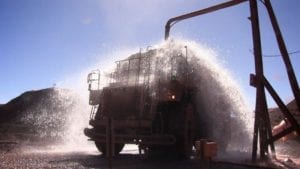According to the latest data released by the Department of Water Affairs’ (DWA) “Weekly State of the Reservoirs” report, the reserves of water storage facilities nationwide have dropped from 76,8% full in 2014, to just 65,3% full as of 2 November 2015. More worryingly, the report revealed that the levels dropped from 66,2% full to the current 65,3%, within the space of just one week.
The local mining industry consumes about 306 000 000m3 of water per year, making up 3% of the country’s entire consumption of 10 200 000 000 m3 from all major dams. Although this is lower than the agricultural (67%), domestic (15%), services (7%) and manufacturing (5%) sectors, the industry can ill-afford any wastage, from both an economic and environmental perspective. Drought-prone commodities and dust South Africa’s platinum belt in the North West province is experiencing water levels well below the national average, with water storage facilities only 53,2% full, down from 64,5% last year. Other mining regions, such as the Northern Cape, Mpumalanga and Gauteng, are not yet as hard-hit, but are still experiencing significant drops in water storage compared to last year. The lower rainfall increases the presence of dust – a pervasive problem that undermines the health of workers, impacts negatively on the surrounding environment and substantially reduces the lifespan of machinery. Environmentally-conscious mining operations are tackling this issue with dust suppression solutions, however increasingly-scarce water is often the main source. Despite being the most commonly used dust suppressant, water is severely limited in its effectiveness. Using only water to control dust is a perpetually costly task that offers limited dust suppression. The futility of wasting time, money, and precious water resources is increased as the water quickly evaporates, and dust is again released into the environment. Water-efficient dust control I-CAT director Anton van der Merwe notes that the company can ensure efficient dust control and full environmental compliance, with innovative and cost-effective products that assist with surface stabilisation, while ensuring a significant reduction in water usage. “Our flagship dust suppressant is RDC 20 – a water soluble anionic polyelectrolyte polymer exclusively developed in-house.”RDC20 is an innovative formulation of blended emulsified co-polymers and ionic modifiers. When sprayed onto the road surface, RDC 20 forms a durable cross linked matrix that binds fine soil particles into larger heavier particles, which are less prone to become airborne. RDC 20 is used on temporary roads, as it is a cost-efficient means to improve road and dust conditions exponentially.
Van der Merwe says that I-CAT has received overwhelmingly positive feedback from mines where the product is applied, and especially where I-CAT is contracted to manage the dust control on mine roads. “The overall ambient dust at our largest operation in the Northern Cape has improved by more than 40%, when compared the readings prior to I-CAT managing the secondary roads at the mine. This is an extraordinary achievement that would not be possible without RDC 20.” Preventing wastage Spillage and overfilling of water bowsers are also a major challenge in the mining industry. Up to 10 000 ℓ/min of water spillage can be saved onsite using I-CAT’s E-CAM system with integrated RFID, a camera-based technology that assists water bowser operators in lining up 85 000 ℓ water bowsers at the filling points located across mine sites. Van der Merwe says that the main function of the E-CAM and RFID systems is to reduce and prevent water spillages and wastages around the filling points, and to effectively manage and control water bowser activities. “This new technology ensures pinpoint alignment without the driver having to set foot outside of the bowser, which reduces any safety hazards related to the driver being outdoors. It also substantially reduces the risk of spillage, leading to significant time, cost and water savings.” Long-term and sustainable solutions Although solutions such as these are now more important than ever in times of severe drought, van der Merwe stresses that I-CAT solutions ensure long-term sustainability long after droughts have passed. This is especially important for a country like South Africa, which experiences an average annual rainfall of 495 mm, well below the global average of 1 033 mm.







